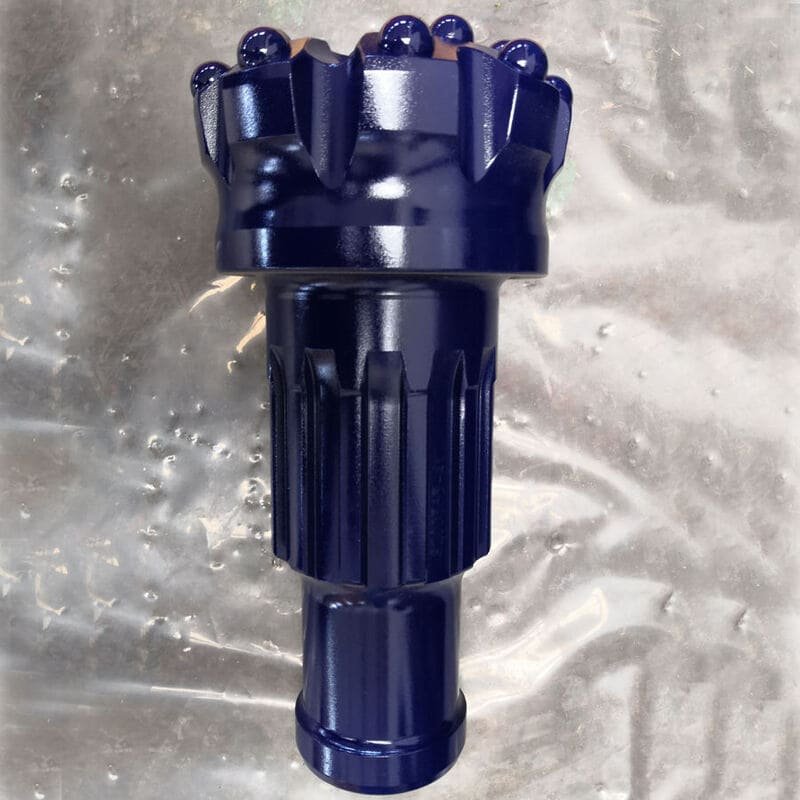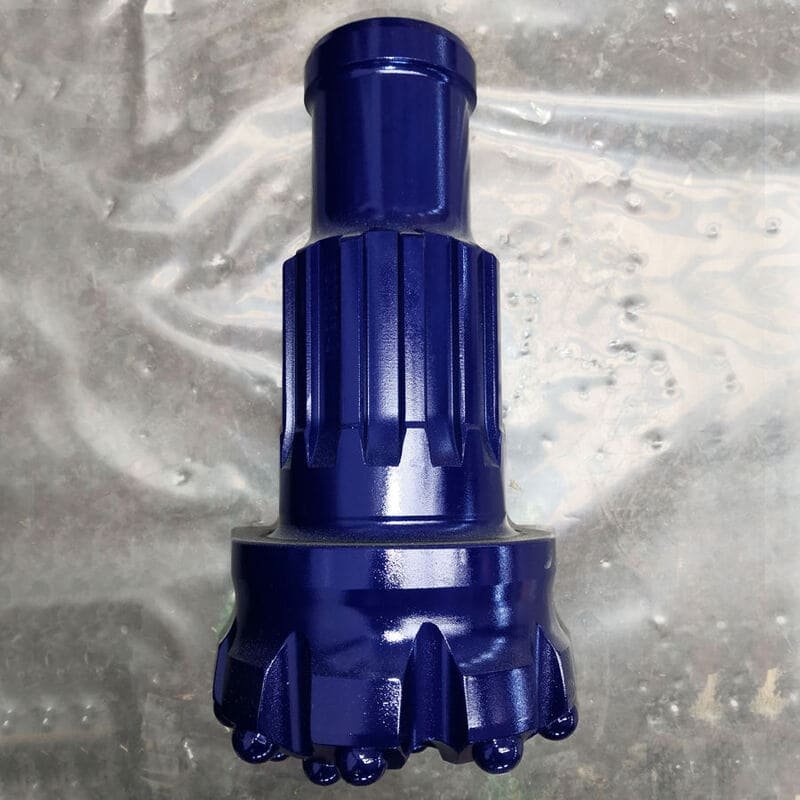
Ever wondered how DTH drill bits withstand extreme drilling conditions? The secret lies in heat treatment.
Heat treatment enhances DTH drill bits by increasing their hardness, strength, and wear resistance, making them more durable against harsh drilling environments. This process involves controlled heating and cooling techniques that improve the microstructure of the steel used in these bits.
I remember the first time I really understood the power of heat treatment. It was during a project where we were drilling through some seriously tough rock formations. We had just switched to a set of heat-treated DTH drill bits, and I couldn’t believe the difference. The bits seemed to slice through the rock like butter, and they lasted significantly longer than our previous sets.
This isn’t just about making the steel harder; it’s about enhancing its entire structure to withstand intense stress and wear. By altering the microstructure through specific heating and cooling cycles, we’re able to boost the hardness and resilience of these tools significantly. This means fewer replacements and more efficient drilling operations—a real game-changer for anyone in the field. Heat-treated bits not only improve performance but also contribute to cost-effectiveness and safety on the job site. It’s fascinating how something as seemingly simple as heating can transform the capabilities of these essential tools.
Heat treatment increases hardness of DTH drill bits.True
Heat treatment alters microstructure, enhancing hardness and durability.
DTH drill bits are made of aluminum for heat treatment.False
DTH drill bits are typically made of steel, not aluminum.
What Are the Key Heat Treatment Processes for DTH Drill Bits?
Ever wondered how those drill bits survive the toughest conditions? It's all about heat treatment magic!
Heat treatment processes for DTH drill bits, like carburizing, quenching and tempering, and surface hardening, enhance their hardness, strength, and wear resistance. This makes them perform optimally in drilling tasks.

Understanding Heat Treatment Processes
I've always been fascinated by the unseen heroes in the drilling world—those robust DTH (Down-The-Hole) drill bits that seem to laugh in the face of rocky challenges. The secret sauce? It's all in the heat treatment processes. These techniques are like giving our drill bits a suit of armor, boosting their durability and functionality. Let's break down these methods: carburizing, quenching and tempering, and surface hardening.
Carburizing
Picture this: the steel is basking in a carbon-rich atmosphere, almost like it's soaking up strength from its surroundings. This is carburizing in action. It toughens up the surface, so when my drill bits face abrasive conditions1, they're more than ready to take on the challenge. Here's a quick look at the magic numbers:
| Carburizing Parameters | Description |
|---|---|
| Temperature | 920°C |
| Carbon Atmosphere | 1.2% initially, then 0.8% |
Quenching and Tempering
After carburizing, there's a sudden chill—quenching—like plunging into an icy pool to seal in that newfound strength. But toughness can't come without balance, which is where tempering steps in, smoothing out the hardness to ensure my drill bits2 can take a beating without cracking under pressure.
Surface Hardening
Sometimes, we need a little extra focus on the most worn parts. Surface hardening is like giving those areas a targeted defense upgrade, using techniques like induction hardening to extend the life of bits working in demanding geological formations.
Analyzing Benefits for Drilling Operations
These heat treatment processes aren't just for show; they bring real advantages to my drilling operations:
- Extended Lifespan: My bits last longer, meaning fewer replacements and less downtime.
- Consistent Performance: Even in harsh conditions, they keep cutting with precision.
- Cost-Effectiveness: While initial costs might be high, the longevity and reliability more than pay off.
- Safety: Fewer failures mean safer working conditions.
These benefits are exactly why understanding heat treatment3 is crucial for anyone looking to get the best out of their DTH drill bits. It's like having a reliable partner who won't let you down even when things get tough.
Carburizing increases surface hardness of drill bits.True
Carburizing enhances surface hardness by increasing carbon content.
Surface hardening is applied to the entire drill bit.False
Surface hardening targets specific areas prone to wear.
How Does Increased Hardness Benefit Drill Bit Performance?
Ever wondered why some drill bits just keep going while others wear out too fast? The secret might just be in their toughness. Let's explore how hardness can supercharge drill bit performance and make your work smoother.
Increased hardness in drill bits boosts their wear resistance and durability, ensuring a longer lifespan and efficient cutting. This is achieved through heat treatment, which alters the steel’s microstructure, enhancing its performance in tough conditions.

The Science Behind Hardness
I remember when I first learned about the magic of hardness in drill bits. It was during a project that involved drilling through some particularly tough rock formations. The bits we used had undergone heat treatment, a process that changes the microstructure of the steel. This change made them not only harder but more resistant to wear and tear.
Benefits of Hardness
It's like having a superpower in your toolbox. Here’s what I found:
- Wear Resistance: A harder drill bit doesn’t give up easily. It holds its own against abrasion, meaning I could use it over and over without losing efficiency.
- Strength and Durability: It's like the perfect balance between being tough and flexible. These bits could handle high-impact forces without shattering, which was a lifesaver during my continuous operations in construction.
| Benefit | Description |
|---|---|
| Wear Resistance | Prolongs the tool's lifespan by resisting abrasion |
| Strength | Balances toughness with durability to prevent breakage |
Heat Treatment Techniques
Various heat treatment methods like carburizing and quenching play a huge role. Carburizing pumps up the surface carbon content, ramping up hardness, while quenching locks in that desired hardness and toughness by rapidly cooling the steel.
Operational Advantages
From my experience, here are some key operational perks:
- Reduced Replacement Frequency: Those harder bits lasted way longer, saving us time and money on replacements.
- Improved Efficiency: Even in tough spots, they kept performing consistently.
For more insights into how hardness gives drill bits an edge in different scenarios, explore technical resources4 that delve into material science and engineering best practices. It's worth the read if you're keen on making informed decisions for your next project.
Harder drill bits have superior wear resistance.True
Increased hardness enhances a drill bit's ability to resist abrasion.
Heat treatment reduces the hardness of drill bits.False
Heat treatment increases hardness by altering the material's microstructure.
Why Is Wear Resistance Important in Drilling Operations?
Drilling is a tough gig, and wear resistance is the unsung hero keeping everything running smoothly and affordably.
Wear resistance is vital in drilling because it extends drill bit life, cuts downtime, and maintains consistent performance. This results in lower costs and higher efficiency in tough environments.

Understanding Wear Resistance in Drilling
When I first got into the drilling business, I learned the hard way how crucial wear resistance is. Think of it as the superpower that protects your drill bits from the relentless battering they endure underground. Wear resistance ensures these bits stay sharp and efficient, allowing them to withstand the grind of abrasive and erosive forces that would otherwise chew them up too soon.
-
Prolonged Lifespan: Picture this: fewer frantic runs to replace worn-out bits. High wear resistance means fewer replacements and less downtime, which can really smooth out operations and keep the team focused on the task at hand.
-
Consistent Performance: There's nothing worse than a drill bit losing its edge halfway through a project. With superior wear resistance, those bits maintain their cutting prowess, even when the going gets tough.
Impact on Operational Costs
The financial side of things was always daunting for me until I understood the real value of wear resistance. Here’s a breakdown of how it saves money and sanity:
| Factor | Impact |
|---|---|
| Reduced Replacements | Fewer replacements lower inventory costs and reduce downtime. |
| Maintenance Savings | Less frequent maintenance reduces labor costs and operational disruptions. |
| Efficiency Gains | Consistent performance improves drilling speed, enhancing productivity. |
Material Innovations
Delving into material science was like unlocking a treasure chest of possibilities. The advancements are nothing short of amazing:
-
Heat Treatment: This process toughens up materials like nothing else. Carburizing and quenching make drill bits hardier and more durable. Learn more about heat treatment5.
-
Tungsten Carbide: Often found at the tips of drill bits, this stuff is incredibly hard and resistant, perfect for those unforgiving environments we often face.
-
Surface Coatings: Techniques like diamond-like carbon (DLC) coatings add an extra layer of protection, further extending the life of the bits.
Choosing the Right Materials
Selecting materials for optimal wear resistance isn't just about picking the hardest substance. It's about finding that sweet spot between hardness and toughness to avoid brittleness. When I'm assessing materials, I consider the geological conditions and specific drilling requirements to make an informed choice.
- Application-Specific Design: Tailoring drill bits to specific applications can significantly boost wear resistance by matching material properties to the conditions they’ll face. Explore custom solutions6.
By keeping these factors in mind, we ensure our drilling operations not only stay efficient but also cost-effective over the long haul, underscoring why wear resistance is indispensable in our industry.
Wear-resistant materials prolong drill bit lifespan.True
High wear resistance reduces wear and tear, extending drill bit life.
Tungsten carbide is not used in drill bit tips.False
Tungsten carbide offers exceptional hardness, ideal for drill tips.
Conclusion
Heat treatment significantly enhances the durability of DTH drill bits by increasing hardness, strength, and wear resistance, ensuring optimal performance in harsh drilling conditions.
-
Discover how carburizing increases surface hardness, enhancing abrasion resistance in industrial applications. ↩
-
Learn how quenching and tempering balance hardness and toughness for improved drill bit durability. ↩
-
Explore why heat treatment is crucial for optimizing drill bit performance and longevity. ↩
-
Discover the material science principles behind improved drill bit performance. ↩
-
Explore how heat treatment processes like carburizing enhance material properties. ↩
-
Discover how tailored drill bits improve performance in specific applications. ↩







